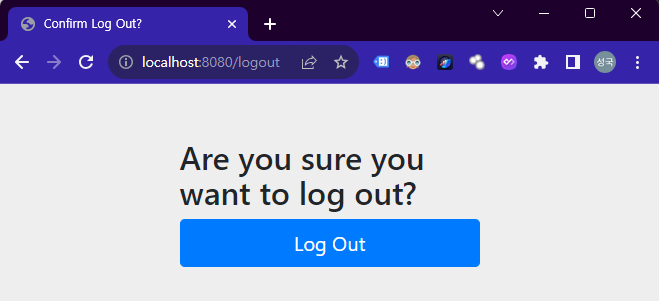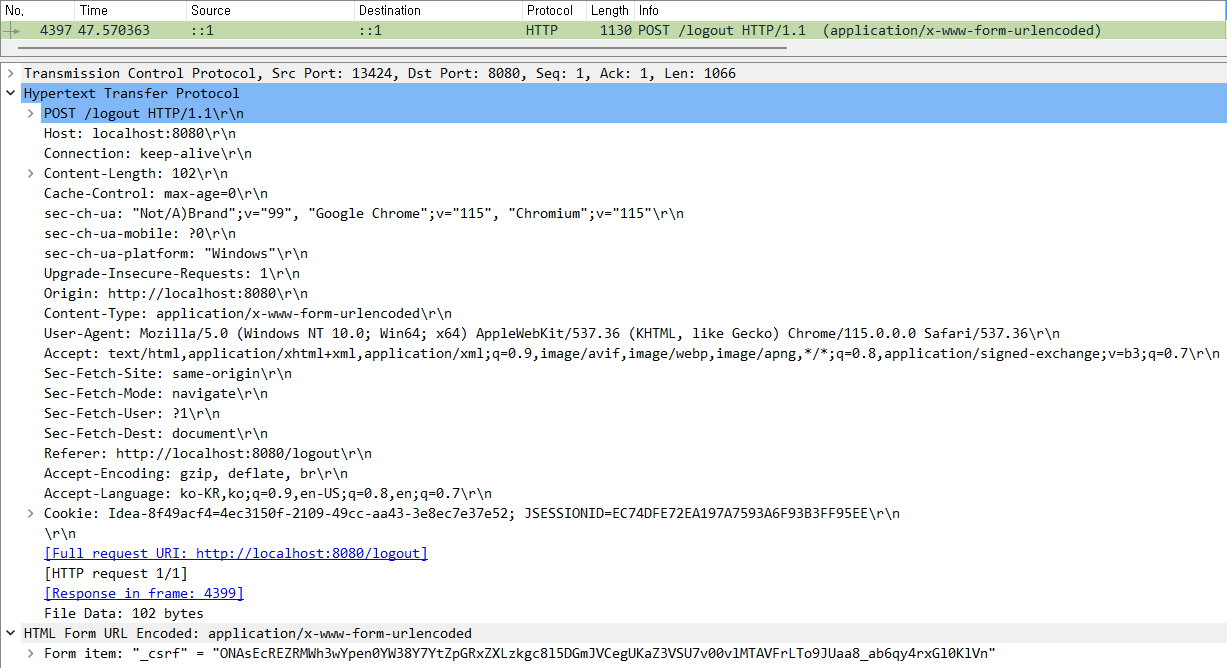Spring Security 로그아웃(Logout) 하기
Intro
Spring Security 를 차근차근 하나씩 보고싶지만, 구현하기도 해야하니 기존에 작성하던 순서를 건너뛰어 Logout 절차 문서를 먼저 간단하게 살펴봤습니다.
어설프게 나마 Logout API를 구현을 한지 좀 됐지만, 감에 의한 구현으로 뭔가 찝찝하기도 하고, 문제도 있어서 문서를 다시 살펴보면서 새롭게 구현했습니다.
요약
HttpServletRequest.logout() 메서드 사용하기
기존 구현
기본적으로 지원하는 경로인 POST /logout 를 통해 요청을 보내는게 적합한 경우도 있지만, ajax를 이용해서 페이지 내 UI 일부만 로그아웃 상태로 변경하기에는 html 응답까지 와버려 적합하지 않았습니다. 그래서 logout 요청을 별도로 보내기 위한 구현을 했습니다.
기존 구현은 SecurityContextHolder를 살펴본 후(작성 글 링크)에 SecurityContext 를 비워버리면 되겠다는 생각을 했고, 실제로는 context 를 clear 한 후 session을 invalidate 했습니다.
1
2
3
4
5
6
7
Optional.of(SecurityContextHolder.getContext()).ifPresentOrElse(
context -> {
SecurityContextHolder.clearContext();
request.getSession(false).invalidate();
},
() -> context가 null 인 경우 처리 코드);
// 이외에는 null 체크와 응답 코드 지정 등 부수적인 코드입니다.
session을 invalidate 해주어야 하는 이유는 SecurityContext 에는 인증을 위해 사용자가 입력한 정보와 인증과 관련된 정보가 담겨있을 뿐, 인증 후 이용되는 정보는 다른 객체(나중에 Spring Security 진도 나가면 추가 예정)에 담겨 session 에 저장되기 때문입니다.
그런데 session은 null 체크 안했었네요.
logout 메서드 찾아보기
그런데 로그아웃을 설마 구현안해놨겠나 싶어서 먼저 예전에 샀던 백엔드 책을보니, 아래와 같은 방식으로 로그아웃 하는게 보입니다.
1
new SecurityContextLogoutHandler().logout(request, response, SecurityContextHolder.getContext().getAuthentication());
logout 메서드를 살펴보면 아래와 같습니다. Javadoc을 보면 response와 authentication은 안쓴다고 하니 null을 주고 로그아웃을 해보면 이상 없이 동작합니다. authentication은 심지어 메서드 내에 전혀 사용되고 있지 않죠.
1
2
3
4
5
6
7
8
9
10
11
12
13
14
15
16
17
18
19
20
21
22
23
24
25
26
/**
* Requires the request to be passed in.
* @param request from which to obtain a HTTP session (cannot be null)
* @param response not used (can be <code>null</code>)
* @param authentication not used (can be <code>null</code>)
*/
@Override
public void logout(HttpServletRequest request, HttpServletResponse response, Authentication authentication) {
Assert.notNull(request, "HttpServletRequest required");
if (this.invalidateHttpSession) {
HttpSession session = request.getSession(false);
if (session != null) {
session.invalidate();
if (this.logger.isDebugEnabled()) {
this.logger.debug(LogMessage.format("Invalidated session %s", session.getId()));
}
}
}
SecurityContext context = this.securityContextHolderStrategy.getContext();
this.securityContextHolderStrategy.clearContext();
if (this.clearAuthentication) {
context.setAuthentication(null);
}
SecurityContext emptyContext = this.securityContextHolderStrategy.createEmptyContext();
this.securityContextRepository.saveContext(emptyContext, request, response);
}
크게 보면 session invalidate 하는 부분, SecurityContext를 비우고 authentication에는 설정에 따라 null을 대입하는 부분, 빈 SecurityContext 를 만들어서 다시 또 저장하는 부분으로 나뉩니다.
SecurityContextHolder는 SecurityContextHolderStrategy 에 static 메서드를 위임한다고 하는 것을 살펴봤었기 때문에(링크), SecurityContextHolderStrategy 에서 clearContext() 하는 거나 SecurityContextHolder 에서 clearContext() 하는 거나 동일하다는 것을 알 수 있습니다.
마지막 saveContext 메서드 내부를 살펴봤을 때, 버려진 코드인 느낌도 있어서 추후에 시간이 된다면 따로 다뤄보겠습니다.
근데 안됨
이것만 해도 session은 invalidate 돼서 UI가 변하니, 로그아웃이 되는 것으로 보입니다.
그런데 로그인 유지 기능, Spring Security 명칭으로는 remember-me 기능을 이용할 때는 로그아웃이 안되는 것을 확인할 수 있습니다.
로그아웃을 누를 때 마다 Session ID를 저장해놓은 쿠키 정보는 계속 갱신되는데, remember-me 쿠키가 계속 유지돼서 로그아웃이 안됩니다.
아마 책 예제에는 로그인 유지 기능이 없어서 그랬던 것 같습니다.
다른 Spring Security 로그아웃 방식을 살펴보려고 구글 검색 결과 1페이지에 있는 블로그만 간단하게 살펴봤는데, 딱히 눈에 들어오는게 없어서 공식 문서를 살펴봤습니다.
Handling Logouts
공식 문서 Logout(링크)를 보면, Spring Security 기본설정으로 로그아웃 기능을 이용하면 GET 또는 POST 방식으로 /logout 경로에 요청 시 로그아웃 절차를 수행한다고 하며, GET /logout 으로 접근하면 로그아웃 확인 페이지를 보여주는데, 어플리케이션에서 사용할 필요 없다고 합니다.
현실적으로도 직접 만든 페이지를 사용하지 기본 로그아웃 페이지를 사용하지는 않겠죠. Log Out 버튼을 누르면 POST 방식으로 /logout 경로에 HTTP 요청을 보냅니다.
POST /logout 요청 시 기본 동작
문서에 이어서 나오는 내용은 POST /logout 요청 시 기본 동작에 대한 내용입니다.
SecurityContextLogoutHandler 를 이용한 과정이 많은 지분을 차지하기는 하지만, 추가적인 절차가 필요한 것을 확인할 수 있습니다.
If you request POST /logout, then it will perform the following default operations using a series of LogoutHandlers:
Invalidate the HTTP session (
SecurityContextLogoutHandler)Clear the
SecurityContextHolderStrategy(SecurityContextLogoutHandler)Clear the
SecurityContextRepository(SecurityContextLogoutHandler)Clean up any RememberMe authentication (
TokenRememberMeServices/PersistentTokenRememberMeServices)Clear out any saved CSRF token (
CsrfLogoutHandler)Fire a
LogoutSuccessEvent(LogoutSuccessEventPublishingLogoutHandler)
Once completed, then it will exercise its default LogoutSuccessHandler which redirects to /login?logout.
그럼 이 절차도 알아서 호출해줄 메서드는 없을까 하면서 문서를 가장 밑으로 내려보니 다른 메서드가 보였습니다.
HttpServletRequest.logout()
문서(링크) 내용을 살펴 보면, 현재 사용자를 로그아웃하는 데 사용할 수 있는 메서드이고, 앞서 봤던 절차들을 수행하기는 하는데 개발자가 지정한 Spring Security configuration 에 따라 다르다고 합니다.
You can use the
HttpServletRequest.logout()method to log out the current user.Typically, this means that the
SecurityContextHolderis cleared out, theHttpSessionis invalidated, any “Remember Me” authentication is cleaned up, and so on. However, the configuredLogoutHandlerimplementations vary, depending on your Spring Security configuration. Note that, afterHttpServletRequest.logout()has been invoked, you are still in charge of writing out a response. Typically, this would involve a redirect to the welcome page.
welcome page 로 redirect 하는 등의 처리는 알아서 해줘야 한다고 하는데, 딱 제가 원하던 겁니다. 그리고 SecurityContextLogoutHandler 의 logout 메서드 뿐만 아니라 다른 정보들도 처리해준다는 것을 알 수 있습니다.
코드 살펴보기
그래도 궁금하니까 코드를 살펴봅니다.
HttpServlet3RequestFactory.java (github 링크)
1
2
3
4
5
6
7
8
9
10
11
12
13
14
15
16
17
18
private class Servlet3SecurityContextHolderAwareRequestWrapper extends SecurityContextHolderAwareRequestWrapper {
// 다른 메서드 생략
@Override
public void logout() throws ServletException {
List<LogoutHandler> handlers = HttpServlet3RequestFactory.this.logoutHandlers;
if (CollectionUtils.isEmpty(handlers)) {
HttpServlet3RequestFactory.this.logger
.debug("logoutHandlers is null, so allowing original HttpServletRequest to handle logout");
super.logout();
return;
}
Authentication authentication = HttpServlet3RequestFactory.this.securityContextHolderStrategy.getContext()
.getAuthentication();
for (LogoutHandler handler : handlers) {
handler.logout(this, this.response, authentication);
}
}
}
코드를 살펴보면 Logout handler 가 없으면 상위 logout 메서드를 호출하고, 있는 경우에는 모든 Logout handlers를 가져와서 각 handler 의 logout 메서드를 호출합니다.
디버거를 이용해서 살펴보면, 저는 별달리 Logout handler 를 custom 해서 추가하거나 한게 없기 때문에, 앞서 POST /logout 요청 시의 기본 동작에서 봤던 handlers를 볼 수 있습니다. 기존에 단독으로 직접 호출했던 SecurityContextLogoutHandler가 눈에 들어옵니다.
그리고 제 코드는 간단하게 수정할 수 있습니다.
1
2
3
4
5
6
7
8
public 반환자료형 logout(HttpServletRequest request) {
try {
request.logout();
} catch (ServletException e) {
return 정상 처리되지 않은 경우 응답;
}
return 정상 처리된 경우 응답;
}
Outro
Spring Security 는 문서가 잘 돼있어서, 문서를 보는게 좋은 것 같습니다. 속도가 너무 느린게 단점이긴 하지만…
다음에는 logout을 어떤 url 경로로 작성할 것인지 다뤄보겠습니다.
애초에 REST API는 아니기 때문에, 큰 의미가 있을지는 모르겠지만, REST API best pratice 를 적용해볼 수 있을만한 것은 최대한 적용해보려고 하고 있습니다.
REST API의 best practice 중에 자원(resource)의 이름을 동사가 아닌 명사로 하라는 것이 있는데, logout 은 동사라 혼란에 빠지게 됩니다.
to be continued…



